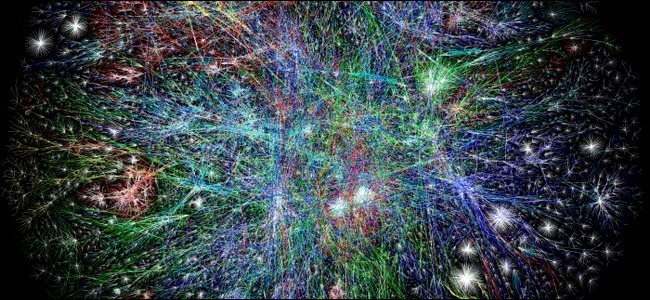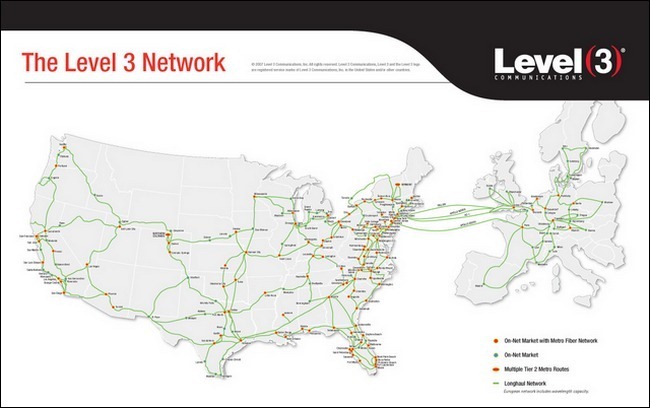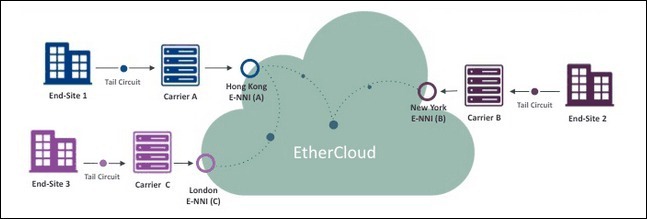
You pay your Internet Service Provider (ISP) for internet access, and they turn on the sweet, sweet, fire hose of data for you. But who provides the flow for your ISP? Read on to learn the ins and outs of global data delivery.
您需要支付Internet服务提供商(ISP)的Internet访问费用,然后他们才能为您打开数据的甜美,温馨,火热的状态。 但是谁为您的ISP提供流量呢? 继续阅读以了解全球数据传输的来龙去脉。
Today’s Question & Answer session comes to us courtesy of SuperUser—a subdivision of Stack Exchange, a community-drive grouping of Q&A web sites.
今天的问答环节由SuperUser提供,它是Stack Exchange的一个分支,它是Q&A网站的社区推动组织。
问题 (The Question)
SuperUser reader KronoS poses the question many geeks have asked at one point:
超级用户读者KronoS提出了许多极客提出的问题:
I’ve been wondering recently about how the infrastructure of the Internet really works.
最近,我一直在想互联网的基础架构是如何工作的。
I know that I have an Internet Service Provider (ISP) that supplies my connection to the Internet.
我知道我有一个Internet服务提供商(ISP)提供与Internet的连接。
But what I don’t know is: Who provides the Internet to the ISP? And who supplies it to them? Is there a never-ending loop that eventually connects us all together?
但是我不知道的是: 谁为ISP提供Internet? 谁提供给他们? 是否有一个永无止境的循环最终将我们大家联系在一起?
Who indeed? It’s networks all the way down, but not all of them are immediately visible to the end user.
谁啊 它的网络一直都在下降,但并不是所有的网络都能立即显示给最终用户。
答案 (The Answer)
Courtesy of SuperUser contributor Tom Wijsman, we’re treated to a detailed peek at how we can determine who specifically is providing internet access to our ISP and what it means to be part of the provider-to-the-providers network.
由超级用户贡献者Tom Wijsman提供,我们将详细了解如何确定谁专门为ISP提供互联网访问,以及成为提供商到提供商网络的一部分意味着什么。
我如何确定互联网的基础设施? (How do I figure out the Internet’s infastructure?)
Let’s suppose we don’t know about the history of the Internet, nor do we have access to any online resources that explains us this. Then, the only way to learn how the Internet infrastructure is built is to go back to the roots. Using existing protocols to discover how our Internet is built.
假设我们不了解Internet的历史 ,也无法访问任何解释这一点的在线资源。 然后, 学习如何构建Internet基础结构的唯一方法是回到源头。 使用现有协议来发现我们的Internet是如何构建的。
Specifically, the Internet Control Message Protocol or ICMP defines the Echo request and the Echo reply. By increasing the Time To Live of an IP packets by 1 each iteration, you can find each next hop on the path to your target. This allows you to get a list of hops between you and your target, the classical traceroute.
具体地说, Internet控制消息协议或ICMP定义了回显请求和回显应答。 通过将IP数据包的生存时间每次迭代增加1,您可以找到目标路径上的每个下一跳。 这样,您就可以获取到您的目标(经典的traceroute)之间的跃点列表。
On Windows, you can use tracert; on Linux and Mac OS X, you can use traceroute.
在Windows上,可以使用tracert 在Linux和Mac OS X上,您可以使用traceroute 。
So, let’s do a traceroute from Belgium to the United States; Stack Exchange looks like a good target.
因此,让我们做一条从比利时到美国的追踪路线; Stack Exchange看起来是一个不错的目标。
Tracing route to stackexchange.com [64.34.119.12] over a maximum of 30 hops:
... redacted ...
5 10 ms 12 ms 12 ms te-3-3.car2.Brussels1.Level3.net [212.3.237.53]
6 11 ms 11 ms 15 ms ae-0-11.bar2.Brussels1.Level3.net [4.69.148.178]
7 20 ms 13 ms 15 ms ae-7-7.ebr1.London1.Level3.net [4.69.148.182]
8 16 ms 16 ms 18 ms vlan101.ebr2.London1.Level3.net [4.69.143.86]
9 83 ms 84 ms 87 ms ae-44-44.ebr1.NewYork1.Level3.net [4.69.137.78]
10 84 ms 93 ms 97 ms ae-71-71.csw2.NewYork1.Level3.net [4.69.134.70]
11 87 ms 96 ms 83 ms ae-2-70.edge1.NewYork1.Level3.net [4.69.155.78]
12 84 ms 93 ms 84 ms gig2-0.nyc-gsr-b.peer1.net [216.187.123.5]
13 87 ms 84 ms 85 ms gwny01.stackoverflow.com [64.34.41.58]
14 87 ms 82 ms 87 ms stackoverflow.com [64.34.119.12]Interesting, we now know that Belgium, London and New York are all connected to Level3. Level3 can be seen as an ISP to ISPs, they simply interconnect multiple ISPs. Here is a picture of how it’s connected:
有趣的是,我们现在知道比利时,伦敦和纽约都连接到Level3 。 Level3可以看作是ISP的ISP,它们只是互连多个ISP。 这是其连接方式的图片:

Let’s go the opposite direction, China! The first thing I could find is the search engine Baidu.
让我们走相反的方向,中国! 我能找到的第一件事是搜索引擎百度。
Tracing route to baidu.com [123.125.114.144] over a maximum of 30 hops:
... redacted ...
5 12 ms 10 ms 12 ms ae0.anr11.ip4.tinet.net [77.67.65.177]
6 167 ms 167 ms 167 ms xe-5-1-0.sjc10.ip4.tinet.net [89.149.185.161]
7 390 ms 388 ms 388 ms as4837.ip4.tinet.net [77.67.79.150]
8 397 ms 393 ms 397 ms 219.158.30.41
9 892 ms * 392 ms 219.158.97.13
10 407 ms 403 ms 403 ms 219.158.11.197
11 452 ms 451 ms 452 ms 219.158.15.5
12 * 434 ms 434 ms 123.126.0.66
13 449 ms 450 ms 450 ms 61.148.3.34
14 432 ms 433 ms 431 ms 202.106.43.66
15 435 ms 435 ms 436 ms 123.125.114.144Well, not much information about the Chinese ISPs there but we at least found Tinet. Here is a nice picture of their site that shows how they connect with the various ISPs:
嗯,关于中国ISP的信息不多,但我们至少找到了Tinet 。 这是他们站点的漂亮图片,显示了他们如何与各种ISP连接:

They simply have a cloud of hops spread about the relevant part of the world they serve, and at the end points they connect to the ISPs. The reason they have a cloud of hops is for reliability, for when some hops fall out.
他们只是在他们所服务的世界的相关部分上散布着一堆跃点云,并且最终它们连接到了ISP。 它们之所以会出现跳数云,是因为可靠性,因为某些跳数会下降。
If you repeat this a few times, you can get an idea of how everything is connected.
如果重复几次,您将了解所有连接的方式 。

那么,有哪些网络层? (So, What Network Tiers Are There?)
The huge networks we found through trace-routing are known as Tier 1 networks.
我们通过跟踪路由发现的巨大网络被称为第1层网络。
Although there is no authority that defines tiers of networks participating in the Internet, the most common definition of a tier 1 network is one that can reach every other network on the Internet without purchasing IP transit or paying settlements.
尽管没有权限来定义参与Internet的网络层,但是第1层网络的最常见定义是可以在不购买IP传输或支付结算费用的情况下访问Internet上的所有其他网络。
By this definition, a tier 1 network is a transit-free network that peers with every other tier-1 network. But not all transit-free networks are tier 1 networks. It is possible to become transit-free by paying for peering or agreeing to settlements.
根据此定义,第1层网络是与其他所有第1层网络对等的无传输网络。 但是,并非所有的无转接网络都是1级网络。 通过支付对等费用或达成和解协议,有可能免于过境。
Common definitions of tier 2 and tier 3 networks:
第2层和第3层网络的通用定义:
Tier 2: A network that peers with some networks, but still purchases IP transit or pays settlements to reach at least some portion of the Internet.
第2层:与某些网络对等但仍购买IP传输或支付结算费用以到达Internet的至少一部分的网络。
Tier 3: A network that solely purchases transit from other networks to reach the Internet.
第3层:仅从其他网络购买中转权才能到达Internet的网络。
If you click through to Tier 1 networks from the Internet Backbone page you get to a list of the current Tier 1 networks:
如果您从“ Internet骨干网”页面单击进入第1层网络 ,则会获得当前第1层网络的列表:
- AT&T from USA 美国AT&T
- Centurylink (formerly Qwest and Savvis) from USA 来自美国的Centurylink(以前是Qwest和Savvis)
- Deutsche Telekom AG from Germany 来自德国的Deutsche Telekom AG
- Inteliquent (formerly Tinet) from USA 来自美国的Inteliquent(以前称为Tinet)
- Verizon Business (formerly UUNET) from USA 来自美国的Verizon Business(以前称为UUNET)
- Sprint from USA 来自美国的Sprint
- TeliaSonera International Carrier from Sweden 瑞典的TeliaSonera国际航空公司
- NTT Communications from Japan 来自日本的NTT Communications
- Level 3 Communications from USA 美国三级通讯
- Tata Communications from India 来自印度的Tata Communications
It is not known if AOL Transit Data Network (ATDN) is still a Tier 1 network.
不知道AOL Transit Data Network (ATDN)是否仍是第1层网络。
等等,什么…… 对等是什么? (Wait, what… What is Peering?)
These networks connect to each other through a process known as ‘peering’. Most traffic needs to go over at least 2 different top tier networks in order to reach its destination, and the networks are bridged with peering arrangements. The way this usually works is that each party to the agreement will commit to routing x amount of traffic for the other party on their network, and vice-verse. There is usually no money exchanged in these arrangements, unless one side is sending or receiving a lot more data than the other sides.
这些网络通过称为“对等”的过程相互连接。 大多数流量都需要经过至少2个不同的顶级网络才能到达目的地,并且这些网络与对等安排桥接在一起。 这通常的工作方式是,协议的每一方都将致力于为其网络上的另一方路由x流量,反之亦然。 在这些安排中,通常不会进行货币兑换,除非一方发送或接收的数据比另一方多。
Large companies can also go out and arrange their own peering relationships. For example Netflix has arranged its own peering and network infrastructure directly with multiple tier-1 networks so that its traffic is both cheaper and closer to end users on each of the popular US broadband ISP’s.
大公司也可以出去安排自己的对等关系。 例如,Netflix已经直接与多个1级网络一起安排了自己的对等和网络基础结构,以使它的流量更便宜,并且更靠近每个流行的美国宽带ISP上的最终用户。
See this Wikipedia page on Peering.
请参阅Peering上的Wikipedia页面 。
There’s a lot more to read at those pages; this answer gives a general idea, discovering all the details are left as an exercise to the reader.
这些页面上还有很多东西要读。 这个答案给出了一个总体思路,发现所有细节留给读者练习。
Have something to add to the explanation? Sound off in the the comments. Want to read more answers from other tech-savvy Stack Exchange users? Check out the full discussion thread here.
有什么补充说明吗? 在评论中听起来不对。 是否想从其他精通Stack Exchange的用户那里获得更多答案? 在此处查看完整的讨论线程 。
翻译自: https://www.howtogeek.com/123599/who-provides-internet-service-for-my-internet-service-provider/




















 2万+
2万+











 被折叠的 条评论
为什么被折叠?
被折叠的 条评论
为什么被折叠?








